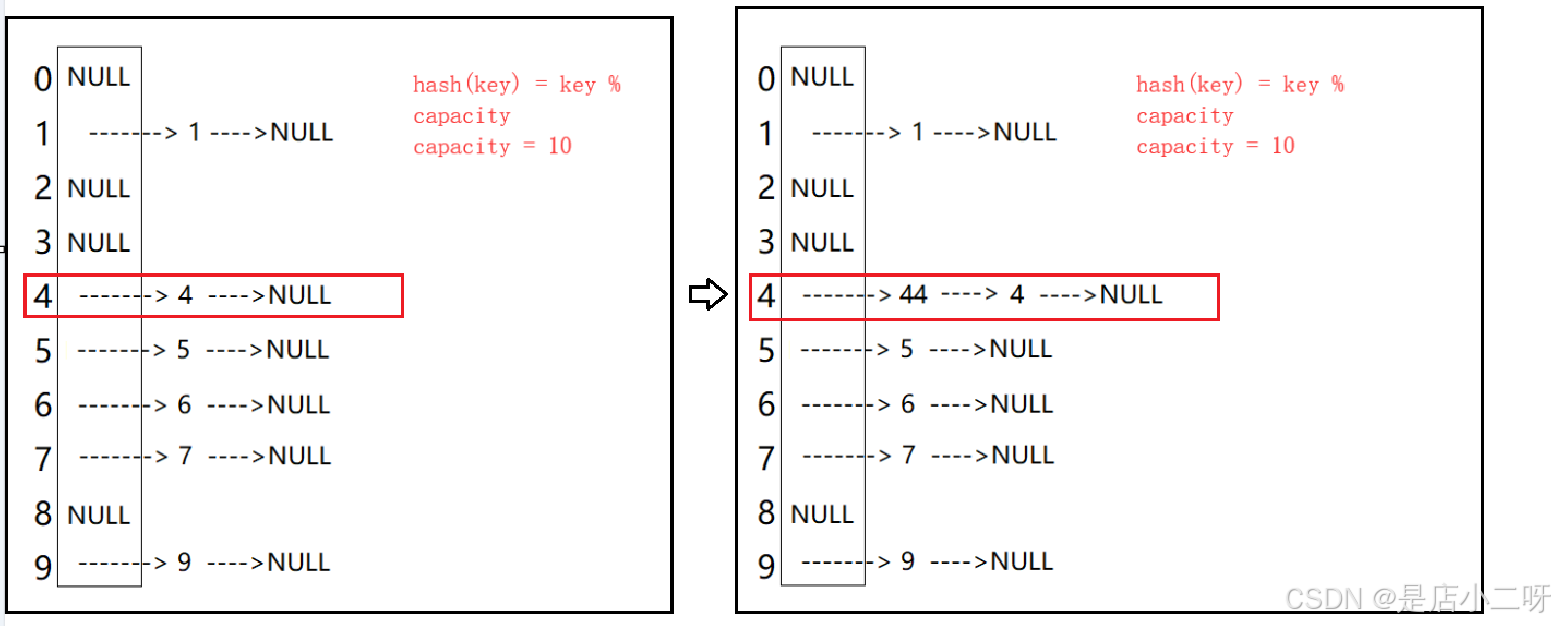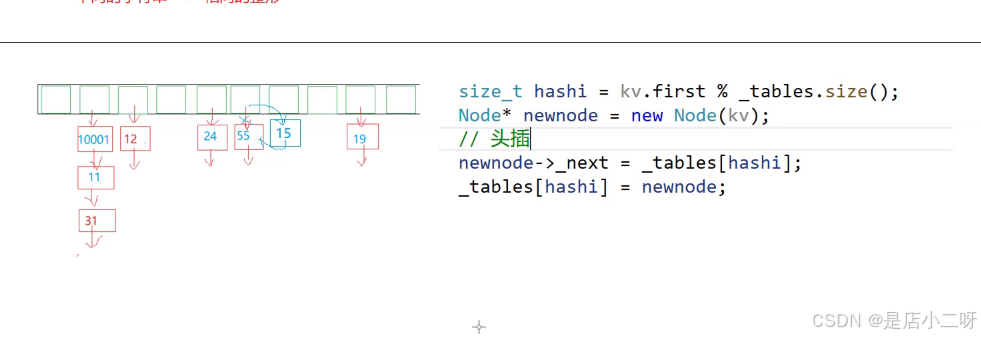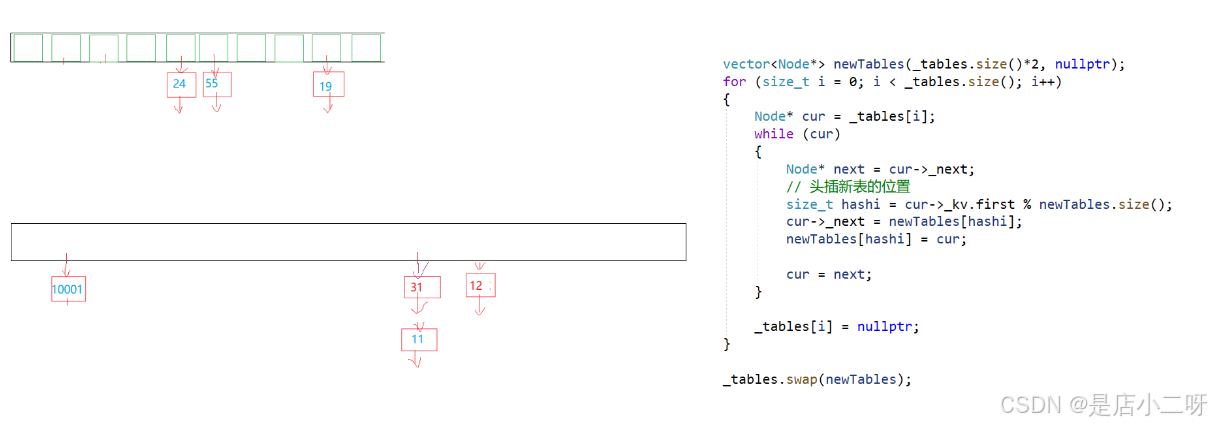
| C++语法 | 相关知识点 | 可以通过点击 | 以下链接进行学习 | 一起加油! |
|---|---|---|---|---|
| 命名空间 | 缺省参数与函数重载 | C++相关特性 | 类和对象-上篇 | 类和对象-中篇 |
| 类和对象-下篇 | 日期类 | C/C++内存管理 | 模板初阶 | String使用 |
| String模拟实现 | Vector使用及其模拟实现 | List使用及其模拟实现 | 容器适配器Stack与Queue | Priority Queue与仿函数 |
| 模板进阶-模板特化 | 面向对象三大特性-继承机制 | 面向对象三大特性-多态机制 | STL 树形结构容器 | 二叉搜索树 |
| AVL树 | 红黑树 | 红黑树封装map/set | 哈希-开篇 | 闭散列-模拟实现哈希 |
在上篇中,我们使用闭散列技术解决了哈希冲突并实现了哈希表。然而,我们发现闭散列并不理想,因此本篇将探讨如何通过开散列方法来处理哈希冲突。


?个人主页:是店小二呀
?C语言专栏:C语言
?C++专栏: C++
?初阶数据结构专栏: 初阶数据结构
?高阶数据结构专栏: 高阶数据结构
?Linux专栏: Linux
?喜欢的诗句:无人扶我青云志 我自踏雪至山巅 
文章目录
一、开散列(哈希桶)二、实现哈希表2.1 哈希表基本构架2.2 哈希表插入数据2.3 哈希表析构函数2.4 哈希表扩容2.5 哈希表删除数据2.6 哈希桶中查找 三、HashTable.h
一、开散列(哈希桶)
开散列法又叫链地址法(开链法),首先对关键码集合用散列函数计算散列地址,具有相同地址的关键码归于同一子集合,每一个子集合称为一个桶,各个桶中的元素通过一个单链表链接起来,各链表的头结点存储在哈希表中。

从上图可以看出,开散列中每个桶中放的都是发生哈希冲突的元素
二、实现哈希表
2.1 哈希表基本构架
template<class K> struct HashFunc { size_t operator()(const K& key) { return (size_t)key; } };template<>struct HashFunc<string>{ size_t operator()(const string& key) { size_t hash = 0; for (auto ch : key) { hash *= 131; hash += ch; } return hash; }};namespace hash_buck{ template<class K,class V> struct HashNode { pair<K, V> _kv; HashNode<K, V> _next; }; template<class K, class V,class Hash = HashFunc<K>> class HashTable { public: typedef HashNode<K, V> Node; HashTable() { _tables.resize(10,nullptr); } private: vector<Node*> _tables; //vector<list<..>> _tables; size_t _n = 0; };}这里如果想实现哈希桶结构,可以使用一个个节点连接起来或者直接套上一个链表容器。这里为了更好地实现迭代器,我们选择第一种方式,第二种方式实现迭代器有一丝麻烦。
开散列中每个桶中放的都是发生哈希冲突的元素 ,并没有顺序之分。
2.2 哈希表插入数据

bool Insert(const pair<K, V>& kv){ Hash hs; size_t hashi = hs(kv.first) % _tables.size(); //进行头插操作 Node* newnode = new Node(kv); _tables[hashi]->_next = newnode; _tables[hashi] = newnode;}这里链表节点只需要单纯地存储数据,那么只需要设计单链表即可,没有必要设双向链表。对于单链表插入数据,一般推荐采用头插,由于尾插需要找尾比较麻烦。
2.3 哈希表析构函数
这里涉及堆上空间资源的开辟,一般需要涉及析构函数进行资源处理。
由于vector容器元素为内置类型,析构函数对内置类型不进行处理,那么就导致指向空间没有得到释放,需要显式写析构函数,完成资源释放。
~HashTable(){ for (size_t i = 0; i < _tables.size(); i++) { Node* cur = _tables[i]; while (cur) { Node* next = cur->_next; delete cur; cur = next; } }}2.4 哈希表扩容
由于哈希桶去解决哈希冲突对于哈希表空间需要相对比较小,不同于开发定址法去解决哈希冲突占用表内空间,而是表中一个指针指向一个空间。
【负载因子满足1即可扩容】:_n == _tables.size()
【第一个方案】:复用Insert完成CV操作
//扩容逻辑 if (_n == _tables.size()) { //这里可以忽略类型 HashTable NewTable; NewTable._tables.resize(n * 10); //CV工作 for (size_t i = 0; i < _tables.size(); i++) { Node* cur = _tables[i]; while (cur) { NewTable.Insert(_tables[i]._kv); cur = cur->_next; } } _tables.swap(NewTable); }【缺陷】:如果存在一万个节点,意味着需要复制一万个节点又要释放一万个节点,显得很浪费
【第二个方案】:直接将节点拿下来

if (_n == _tables.size()){ vector<Node*> NewTable(n * 10, nullptr); for (size_t i = 0; i < _tables.size(); i++) { Node* cur = _tables[i]; while (cur) { Node* next = cur->_next; cur->_next = _tables[i]; _tables[i] = cur; cur = cur->_next; } _tables[i] = nullptr; } _tables.swap(NewTable);}关于这段代码是比较难懂,每个指针指向一块空间,先cur->next = newTables[hashi]抓住新表的位置,newTables[hashi] = cur新表将旧表节点拿下来,可以好好理解拿下来的逻辑,得到了这个地址,这个地址指向一块节点。
这里会导致newTables[hashi]和_tables[i]共同指向一块空间,虽然不会去使用旧表去影响到新表,为了保险起见,可以将旧表这块位置指针置空。
2.5 哈希表删除数据
bool Erase(const K& key){ Hash hs; size_t hashi = hs(kv.first) % _tables.size(); Node* cur = _tables[hashi]; Node* prev = nullptr; while (cur) { if (cur->_kv.first == key) { if (prev == nullptr) { _tables[hashi] = cur->_next; } else { prev->_next = cur->_next; } delete cur; return true; } else { prev = cur; cur = cur->_next; } } return false;}这里删除数据,无非需要考虑两种情况的删除,一种是删除第一个节点,另一种是删除其他节点prev->_next = cur->_next。在删除节点需要前后兼顾,保存下前驱指针指向节点。
2.6 哈希桶中查找
Node* Find(const K& key){ Hash hs; size_t hashi = hs(kv.first) % _tables.size(); Node* cur = _tables[hashi]; while (cur) { if (cur->_kv.first == key) { return &cur->_kv.first; } else { cur = cur->_next; } } return nullptr;}三、HashTable.h
template<class K> struct HashFunc { size_t operator()(const K& key) { return (size_t)key; } };template<>struct HashFunc<string>{ size_t operator()(const string& key) { size_t hash = 0; for (auto ch : key) { hash *= 131; hash += ch; } return hash; }};namespace hash_bucket{ template<class K,class V> struct HashNode { pair<K, V> _kv; HashNode<K, V> _next; }; template<class K, class V,class Hash = HashFunc<K>> class HashTable { public: typedef HashNode<K, V> Node; HashTable() { _tables.resize(10,nullptr); } ~HashTable() { for (size_t i = 0; i < _tables.size(); i++) { Node* cur = _tables[i]; while (cur) { Node* next = cur->_next; delete cur; cur = next; } } } bool Insert(const pair<K, V>& kv) { Hash hs; size_t hashi = hs(kv.first) % _tables.size(); //扩容逻辑 //if (_n == _tables.size()) //{ ////这里可以忽略类型 //HashTable NewTable; //NewTable._tables.resize(n * 10); // ////CV工作 //for (size_t i = 0; i < _tables.size(); i++) //{ //Node* cur = _tables[i]; //while (cur) //{ //NewTable.Insert(_tables[i]._kv); //cur = cur->_next; //} //} //_tables.swap(NewTable); //} if (_n == _tables.size()) { vector<Node*> NewTable(n * 10, nullptr); for (size_t i = 0; i < _tables.size(); i++) { Node* cur = _tables[i]; while (cur) { Node* next = cur->_next; // 头插新表的位置 size_t hashi = hs(kot(cur->_data)) % NewTable.size(); cur->_next = NewTable[hashi]; NewTable[hashi] = cur; cur = cur->_next; } _tables[i] = nullptr; } _tables.swap(NewTable); } //进行头插操作 Node* newnode = new Node(kv); _tables[hashi]->_next = newnode; _tables[hashi] = newnode; ++_n; } Node* Find(const K& key) { Hash hs; size_t hashi = hs(kv.first) % _tables.size(); Node* cur = _tables[hashi]; while (cur) { if (cur->_kv.first == key) { return &cur->_kv.first; } else { cur = cur->_next; } } return nullptr; } bool Erase(const K& key) { Hash hs; size_t hashi = hs(kv.first) % _tables.size(); Node* cur = _tables[hashi]; Node* prev = nullptr; while (cur) { if (cur->_kv.first == key) { if (prev == nullptr) { _tables[hashi] = cur->_next; } else { prev->_next = cur->_next; } delete cur; return true; } else { prev = cur; cur = cur->_next; } } return false; } private: vector<Node*> _tables; size_t _n = 0; };}
以上就是本篇文章的所有内容,在此感谢大家的观看!这里是店小二呀C++笔记,希望对你在学习C++语言旅途中有所帮助!